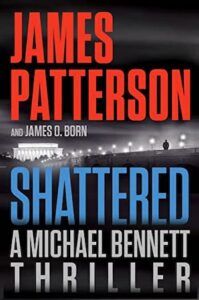Nothing could tear Detective Michael Bennett away from his new bride—except the murder of his best friend. NYPD master homicide investigator Michael Bennett and FBI abduction specialist Emily Parker have a history. When she fails to show at FBI headquarters in Washington, DC, Bennett ventures outside his jurisdiction. The investigation he undertakes is the most brilliant detective work of his career…and the most intensely personal. A portrait begins to emerge of a woman as adept at keeping secrets as forging powerful connections. A woman whose enemies had the means and the motives to silence her —and her protectors. Of course, Clue was a board game before it was adapted into a film in 1985. But we’re talking about the movie Clue here. Clue is a black comedy mystery film directed by Jonathan Lynn and written by Lynn and John Landis. But one of the things you probably remember the most from this iconic movie is the ensemble cast, featuring Tim Curry, Madeline Kahn, Eileen Brennan, Christopher Lloyd, Michael McKean, Martin Mull, and Lesly Ann Warren. At the time of its release in December 1985, Clue was initially a bit of a dud. In general, critics were not fans, and the movie only grossed 14.6 million during its box office run. But since then, the movie has become a cult classic, with many people revisiting the film and reexamining its merits. Aside from the stellar cast and wonderful comedic performances (from Tim Curry especially), what’s the main reason this movie remains a fan favorite nearly 40 years later? You guessed it. It’s the well-constructed mystery. So mystery authors everywhere take note. Here are the things that make Clue the perfect murder mystery. To be fair, not everyone loved the movie’s multiple endings. In his review, Gene Siskel argued, “Think about it. If we know [that there are three different endings] walking into the movie, then we really can’t get too excited about guessing whodunnit because literally anyone could’ve done it. And anybody did do it. Three different people did do it. And that cuts the heart out of the tension of a mystery. Either Paramount should have shown all three endings. Or, better yet, simply strengthen the script and pick the best ending.” In Clue, seven strangers are invited to a dinner party at a secluded New England mansion. After it’s revealed that one of the guests — Mr. Boddy — has been blackmailing the rest of the guests, the lights go out, and when they’re turned back on, Mr. Boddy is on the floor, apparently murdered. Someone in the room is guilty of committing the crime, but who? No one will be leaving the mansion until the murderer is found out. This set-up makes for an interesting mystery because each character legitimately feels like they could be the murderer. And every time you’re about to write someone off as clearly innocent, a turn happens in the story to bring them all back under suspicion yet again. This is actually surprisingly difficult to accomplish for a lot of murder mysteries. Even for the murder mystery novels that do feature a large cast of potential suspects, one or two often end up becoming the main suspects pretty early on. Or one seems like such an obvious suspect that it becomes clear it can’t possibly be that person. The beauty of Clue is that all eight of the main characters are real suspects, all the way to the very end of the movie. The tension doesn’t end there, however. As the characters investigate the house, revelations are made, secrets are discovered, and, yes, more people end up murdered. Certainly a murder is necessary to get the ball rolling in a murder mystery, but the stakes must be raised throughout the story to keep viewers (or readers) interested, and Clue is able to accomplish that expertly. Maybe this is part of the reason the movie was more successful after its theatrical release. When the movie was released for home viewings, it included all three endings, with the additional information that the first two endings could have happened, but that the third ending was what really happened. The reason I would argue that all three endings work is that all of the endings are backed up with evidence from earlier in the film. The final ending is the strongest ending because it makes the most sense when connected with other details in the story. Technically, you can’t guess the ending of this one because three endings are totally possible. However, isn’t it kind of disappointing when you guess the ending anyway? With the best murder mysteries, you’re given enough details so that the ending feels earned, but you’re not given so many details that the ending feels obvious. Clue does this perfectly. For more recent murder mystery novels, check out the works of Lucy Foley, whose novels The Hunting Party, The Guest List, and The Paris Apartment all feature several suspects and many twists and turns. And then there’s Rachel Howzell Hall’s They All Fall Down, which is an excellent update on an Agatha Christie classic. And of course there is the recent Clue Mystery YA trilogy based on the board game (the first book is In the Hall with the Knife) by Diana Peterfreund. It’s clear that Clue takes some of it cues from classic Agatha Christie whodunnits. Books like Murder on the Orient Express and And Then There Were None feature a large cast of suspects in locked room situations. The classic middle grade novel The Westing Game also has major clue vibes, with a large cast of characters working together to solve the mystery. Looking for even more mystery recommendations? Try the ten best mysteries with a twist, make sure to listen in to Book Riot’s Read or Dead podcast, and check out the rest of our Mystery/Thriller week for so much more mystery content.
